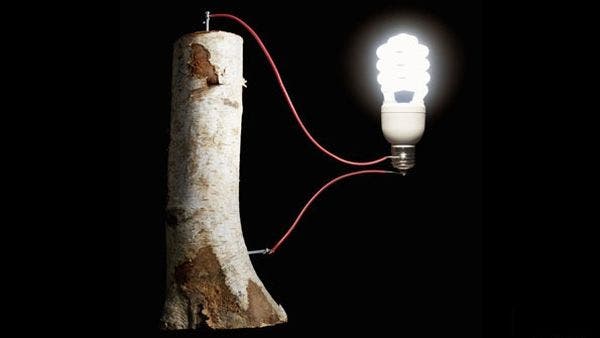A team of researchers from the KTH Royal Institute of Technology and Stanford University has developed a method for making elastic, shock-resistant, high-capacity batteries from wood pulp.

The process for creating the material begins with breaking down tree fibers, making them roughly one million times thinner. The nanocellulose is first dissolved, frozen and then freeze-dried so that water is mechanically eliminated without passing through a liquid state. The material then goes through a process in which the molecules are stabilised so that the material does not collapse.
“The result is a material that is both strong, light and soft,” says Max Hamedi, researcher at KTH and Harvard University. “The material resembles foam in a mattress, though it is a little harder, lighter and more porous. You can touch it without it breaking.”
The resulting aerogel is treated with electrically-conductive ink to give it the ability to store energy, the authors report in the publisher paper. “We use a very precise technique, verging on the atomic level, which adds ink that conducts electricity within the aerogel. You can coat the entire surface within.”

Hamedi compares the battery’s structure to that of a pair of human lungs – when unfurled, they can cover huge surfaces, almost as much as a football field. A single cubic decimeter of the battery could cover most of a football pitch. “You can press it as much as you want; While flexible and stretchable electronics already exist, the insensitivity to shock and impact are somewhat new” he says.
Another benefit of the new method is that it can be used to create three-dimensional structures:
“It is possible to make incredible materials from trees and cellulose. One benefit of the new wood-based aerogel material is that it can be used for three-dimensional structures. There are limits to how thin a battery can be, but that becomes less relevant in 3D, ” Hamedi says. “We are no longer restricted to two dimensions. We can build in three dimensions, enabling us to fit more electronics in a smaller space. Three-dimensional, porous materials have been regarded as an obstacle to building electrodes. But we have proven that this is not a problem. In fact, this type of structure and material architecture allows flexibility and freedom in the design of batteries,” he added.
Hamedi says the aerogel batteries could be used in electric car bodies, as well as in clothing, providing the garment has a lining.






